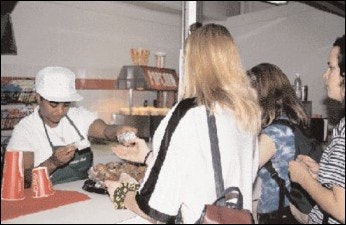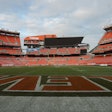Compliance with local, state and federal health and safety regulations is a concern for even the smallest concessions operations

Selling concessions is big business for everyone in the sports and recreation industry, from professional sports franchises and university athletic programs that offer full-blown menus and private skybox dining to local youth groups and high school sports teams that peddle popcorn, hot dogs and soda.
The bigger players often contract out their concessions to a professional or hire an outside agency to develop their service and train their workers. The smaller operators, on the other hand, are on their own in determining what to sell, how much to charge, and how, when and where to sell it. To make educated decisions in these areas, a concessions operator must be knowledgeable about the foods available and about the people who will buy it. Would customers prefer hot dogs, nachos or pretzels. How much are they willing to pay for a hot cup of coffee? Might they purchase food after an event? What is the best way to get their attention?
Finding the right answers to such questions certainly is key to the overall success of a concessions operation. However, a more fundamental and often overlooked issue - health and safety regulations dictated by local, state and federal governments - plays an even bigger part. Without first complying with fire, electrical, plumbing and other building codes, a concessions operation cannot operate at all.
In the food-service business, the rules regarding health and safety are vast and often complicated. They go far beyond hand-washing rituals and properly marked fire exits. What can make the rules more confusing for concessions operators is that many are not consistent from state to state or even from county to county.
The inconsistency may be a symptom of an evolving concessions market. Years ago, concessions stands carried only a handful of easy-to-prepare items. Today, it's not uncommon to find pizzas, steak sandwiches, salads and french fries for sale.
Even the smallest operations can no longer settle for selling just candy and peanuts. With so many different food options available, the profit potential is just too great. (See "Tasty Opportunities," November 1997, p. 59.)
"They're getting into the more hazardous food groups that require grills and fryers," says Theresa Traulsen, president of Concession Solutions, a Seattle-area consulting firm. "Concessions are becoming more like restaurants, so they're being treated more like restaurants."
In all cases, any place that serves food must possess a license to do so. This is true for both permanent and temporary concessions stands. If a facility has more than one concessions area, a license is generally required for each location. Most everything else depends on the nature of the facility - whether it's a makeshift stand, a mobile trailer or a dedicated room or building - and the menu.
The facility itself will also determine which governing bodies will oversee the concessions operation. The Occupational Safety and Health Administration, a U.S. Department of Labor agency, governs only privately owned businesses. However, policies developed by OSHA are very often reflected in state, county and municipal regulations. Many universities and colleges also have their own health and safety departments, and therefore employ their own inspectors, who normally operate according to state guidelines.
To learn the regulations with which a particular concessions operation should comply, Traulsen suggests starting at the most local level. Most smaller operations should first contact their municipal health department. She also stresses the importance of speaking with the inspectors who will actually visit the site. "A lot depends on the people who do the inspections," she says. "They have their own preferences and pet peeves, if you will, that may not be detailed to the letter in the written laws."
The local contact can then help determine which other offices should be queried. Several different departments will ultimately need to be involved if all fire, electrical, plumbing and health requirements are to be met. All facets of the concessions operation - the location of the stand, its spatial dimensions, the equipment being used and the food served - will affect which regulations come into play.
The location of a concessions operation in relation to other concessions and food-service areas dictates what kind of stand is most appropriate.
For example, Oklahoma City Community College operates a small concessions area outside its pool, gym and wellness center. Because the area is just a few hundred feet from the school's cafeteria and several vending machines, a movable cart surrounded by a few tables is an adequate supplement. Customers can find chips and candy in the vending area and can purchase hot foods in the cafeteria, so lower-maintenance food items, such as fruit, vegetables, yogurt and tap soda, are served from the cart. If the cafeteria is closed, sandwiches and other foods that have been prepared in the kitchen are also sold from the cart. This setup cuts down on the stand's electrical needs (all necessary appliances can be safely plugged into a nearby outlet) and the need for elaborate cleaning regimens.
"If the cafeteria were more difficult to get to, we would have focused on a different arrangement," says Bill Coffey, the college's coordinator of service contracts. "With this kind of situation, we don't need to put down heavy equipment or install a sink to wash utensils."
Mobile carts can be an option for more advanced operations as well. Many carts now include, as standard equipment, everything necessary for cooking, including grills, steamers and sinks. Rules surrounding mobile carts vary greatly by state and county. In California, which Traulsen says is probably the strictest when it comes to food-service regulations, you may be able to carry steamed hot dogs on a cart, but you can't have a roller grill. In the state of Washington, however, you can cook just about anything, including chicken or hamburgers, provided there is a sink on the cart for hand-washing.
Any concessions operation that prepares raw food must have a hand sink, and in addition, most must have (or have access to) a three-compartment sink. Those that prepare easy food items such as pretzels and popcorn may require only a hand sink. While having a hand sink on site is ideal, the sink in the nearest rest room is sometimes adequate, provided the rest room is within a certain walking distance.
Concessions must be located close to rest rooms for the convenience of workers as well. They shouldn't have to travel too far or stand in line to wait to use the facilities. If the public rest rooms don't meet these guidelines, facilities designed specifically for concessionaires must be provided.
If restricted-space issues lead to cutbacks, Traulsen warns not to compromise those spaces that might change the operation's quality of service, including point-of-sale and food-preparation areas. All stands should have a sanitary prep area, a cooking area and a warming area. Without these defined areas, the chain of operation can become muddled and the operation less efficient.
"How long customers have to stand in line is directly related to your profits and losses," Traulsen says.
Dave Gottfried, general manager of the class-A Modesto (Calif.) A's baseball team, cites storage requirements as an important spatial consideration. "If your storage area is a certain number of square feet, it will require a sprinkler system, which obviously increases the cost," he says. "When space and budgets get cut, storage isn't always treated as the necessity it really is."
Attention should also be given to the amount of equipment that can safely be operated in the available space. Fire laws and the amount of power allotted to the concessions area will define a safe level of equipment usage. That, in turn, will help determine the amount of food that can be prepared in the space.
"There was a set amount of power sent to our site," says Gottfried. "They didn't consult with us before the power was delegated, so we were left shortchanged. We're working around it, but it did limit our flexibility in trying some new food items."
Some equipment, especially larger, more complex pieces, can be affected by spatial constraints and stand location. The location of the concessions stand at the Modesto ballpark, for instance, turned the installation of a hood-and-vent system for a grill into a more intricate affair.
"The way the grandstand was built, we had to clear everything with the architects as well as the fire, health and building officials," says Gottfried. "It required one signature after another, and one wouldn't sign until the other two people signed - it was very detailed and confusing."
Operations like Modesto's, which is in close proximity to the ballfield - where a lot of dust and debris is kicked up - often require screened or full-glass service windows that can be opened and shut. Concessions stands inside a facility can usually stick to an open counter arrangement.
Outdoor facilities also need to be prepared for more frequent visits from inspectors. Alan Day, general manager of Game Time Sports Services, a California-based food service business, says outdoor operations need to be more cognizant of air quality and rodent and insect problems, as well as the effect the outside temperatures might have on equipment.
"The health department regulates food at certain temperatures," says Day. "The refrigerators need to be cooled down to a set temperature and foods have to be cooked above a set temperature to make sure there is no contamination."
Says Traulsen: "If you're in a cold area and you're constantly opening and shutting the lids on the hot dog warmers - even if you have the machine cranked up to high - that won't keep food at that set temperature."
Some facilities may be allowed to cook food outside because the fire in an outdoor grill is hot enough to kill germs and the smoke created is an adequate deterrent for insects. Once the food is taken away from the flame, however, it must be taken back inside and handed to the customer through the window.
"It all has to do with where you place the product," says Day. "Food has to be in a covered area or packaged if you're outside."
More and more, people like to know that the food they're buying has been protected. Because of that, newer concessions operations often have open designs that make it easier for customers to actually see the clean and safe methods used to prepare their food.
Many operations require workers to wear gloves or use tongs and papers when handling food, whether or not it is required by law. Many also require hair restraints - a cap of some kind is usually sufficient for most workers.
The fear of food contamination has definitely changed the face of concessions. The popularity of bottled water is a good example. While it is a trendy product, it is also a sealed item that people feel is safe to consume.
"Several years ago if you had told concessions people to carry bottled water, they'd say you were nuts," says Traulsen. "Who is going to pay $2 for water when they can drink it from a fountain for free? Today, if a sports facility doesn't have it, they'll get a lot of complaints."
At one time, Grandma's pies could be found for sale over the counter, but the threat of E. Coli contamination and other problems related to undercooked beef and chicken make the sale of home-cooked goods at a concessions stand unacceptable.
Foods prepared in an on- or off-site regulated commercial kitchen can be sold at concessions stands, however, a strategy that Oklahoma City's Coffey has found successful. "I would recommend it to anyone, especially those who are just starting out," he says. "That way they can see how the pre-made items work and then gradually expand from there. It's easy to get an awful lot of money tied up in a short period of time, so this is a good means of finding out what products are selling before you invest in the equipment."
Oklahoma City Community College also makes use of prepackaged items that can be microwaved. There's a wide variety of these products available, including barbecue sandwiches, pita sandwiches and burritos. "It's obviously not as good as serving food fresh from the grill, but it's a step toward that," Coffey says. "The items are packaged so people are comfortable with them and the equipment needed is minimal."
According to Traulsen, there are areas where use of some prepackaged food items is required. This most often applies to condiments and varies widely between locations. "I worked with two minor-league baseball teams, located within an hour of one another, with similar concessions operations," says Traulsen. "Each had different inspectors and different rules to follow. One could serve ketchup in pumps, the other had to use packaged ketchup. One could offer coleslaw on the condiment table, the other could not."
Some areas are also getting strict with nacho cheese, she adds. Packaged chips and cheese that are heated in a warmer are often preferable to having workers handle the chips and scoop the cheese with a utensil. With these packaged items, the possibility of contamination is eliminated and the cheese temperature can be better regulated.
To help ease the minds of customers and concessionaires and to reduce the risk of food contamination, many states are requiring that workers obtain a food handler's license (sometimes called a health card). To obtain this license a worker has to attend a class or classes and be tested on the basics of food service, which include details on the preparation, cooking, serving and handling of food.
Some states do not yet require such a license. Some make all workers, whether food handlers or order takers, obtain a license. Others require just the lead worker or workers to carry a license. In those cases, the leaders are usually responsible for training the rest of the staff.
"Training is absolutely necessary," says Traulsen, "or you will have problems, whether it be with service, quality of food served, food at the right temperatures, health problems or cash delivery."
Proper training of workers is the best tool a concessions operator can have to stay compliant with the list of health and safety regulations they must follow. Just one mishap can be devastating, says Coffey.
"For a big outside event we might draw in 40,000 to 60,000 people over a three-day period. With that kind of crowd, we can't afford to have any problems," he says. "We do our absolute utmost to make sure we are offering top-quality food and service."
Trying to meet all the guidelines initially can be confusing, but proper education on the regulations and a fair amount of planning can alleviate some of the burden.
"What it comes down to is we're really marketing and operations people," says Gottfried. "We put on events, but we're by no means contractors or building experts. This is a big enough business for most facilities that you have to find out what you can and can't do and what the alternatives are. Maybe you'll find out there are no alternatives. In most cases, any upfront expenditures you incur - whether time or money - will save you tenfold down the road."




































